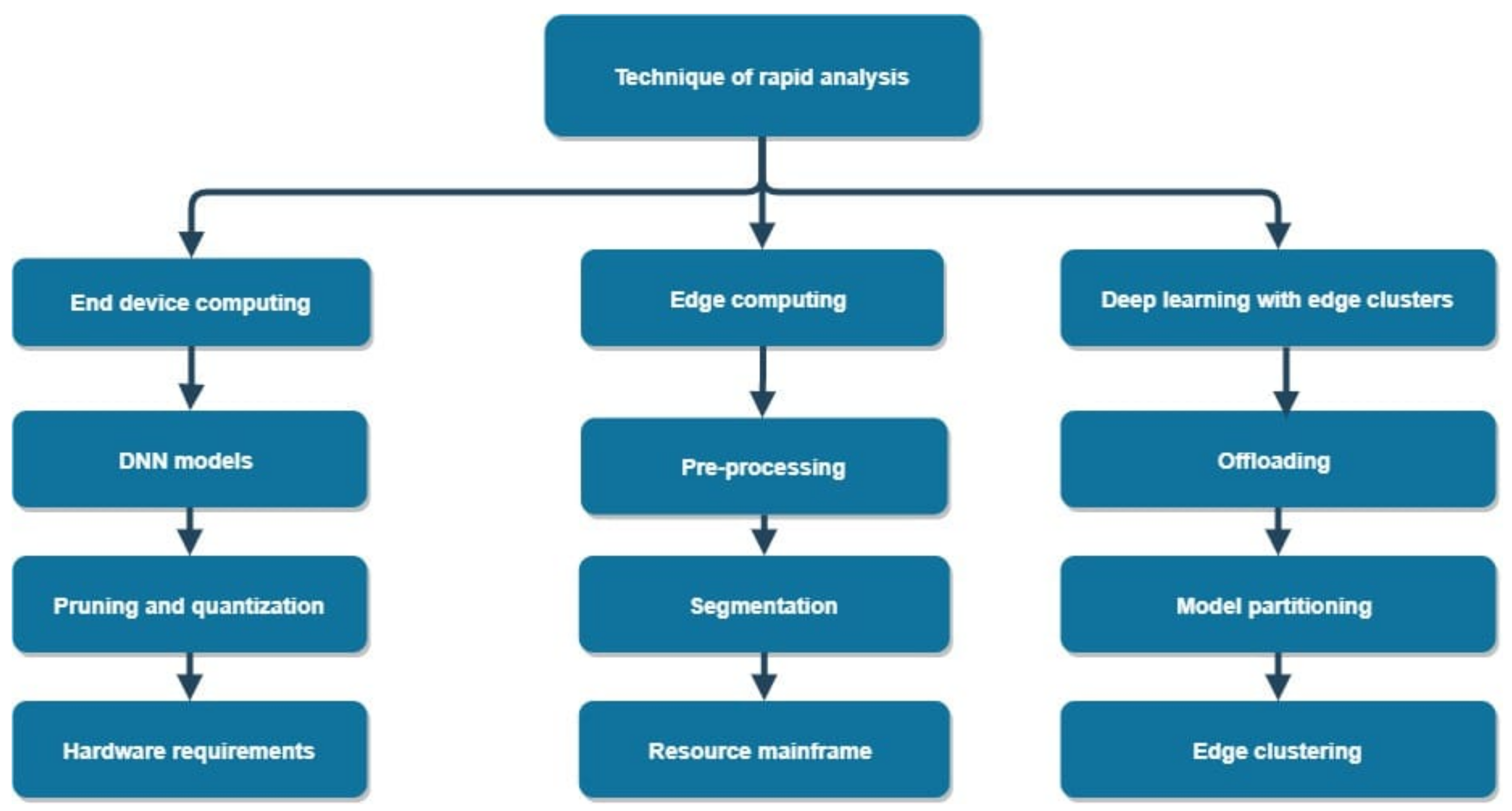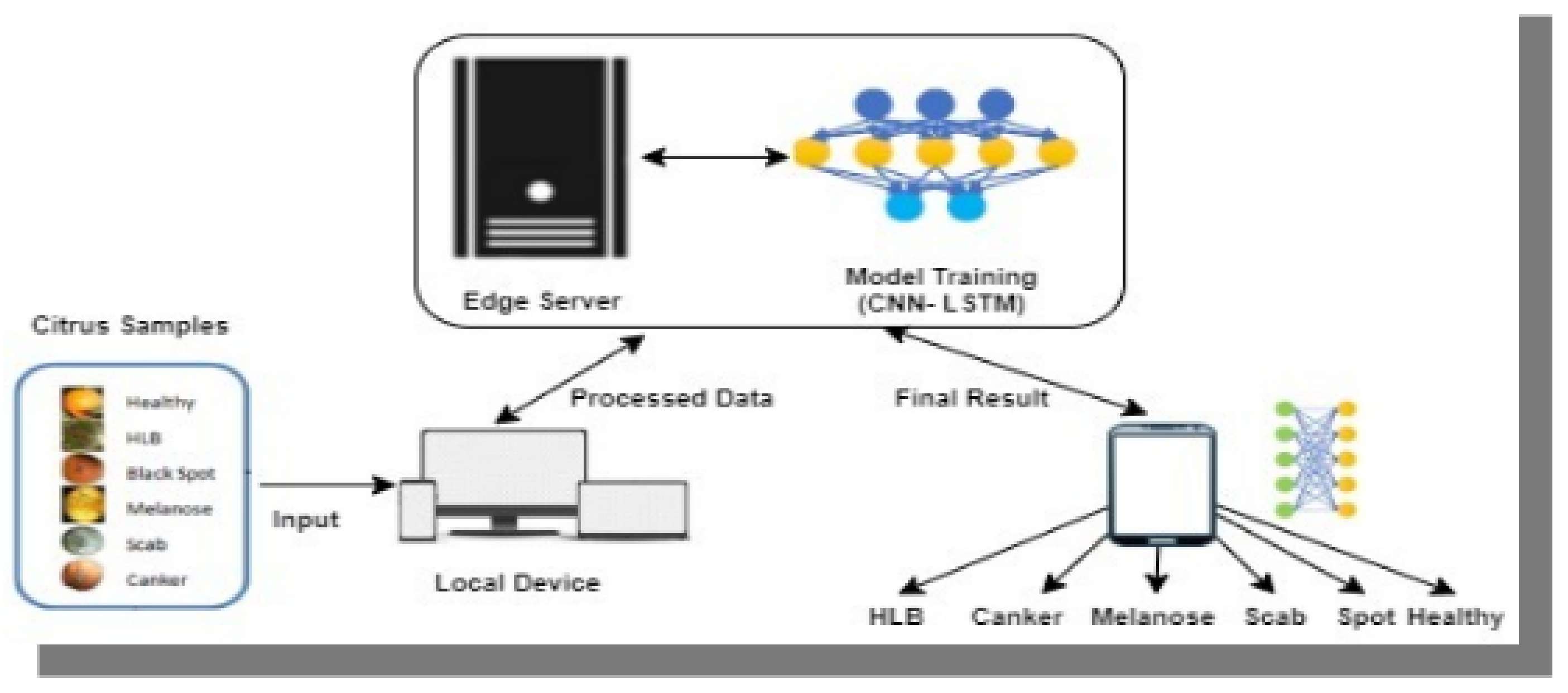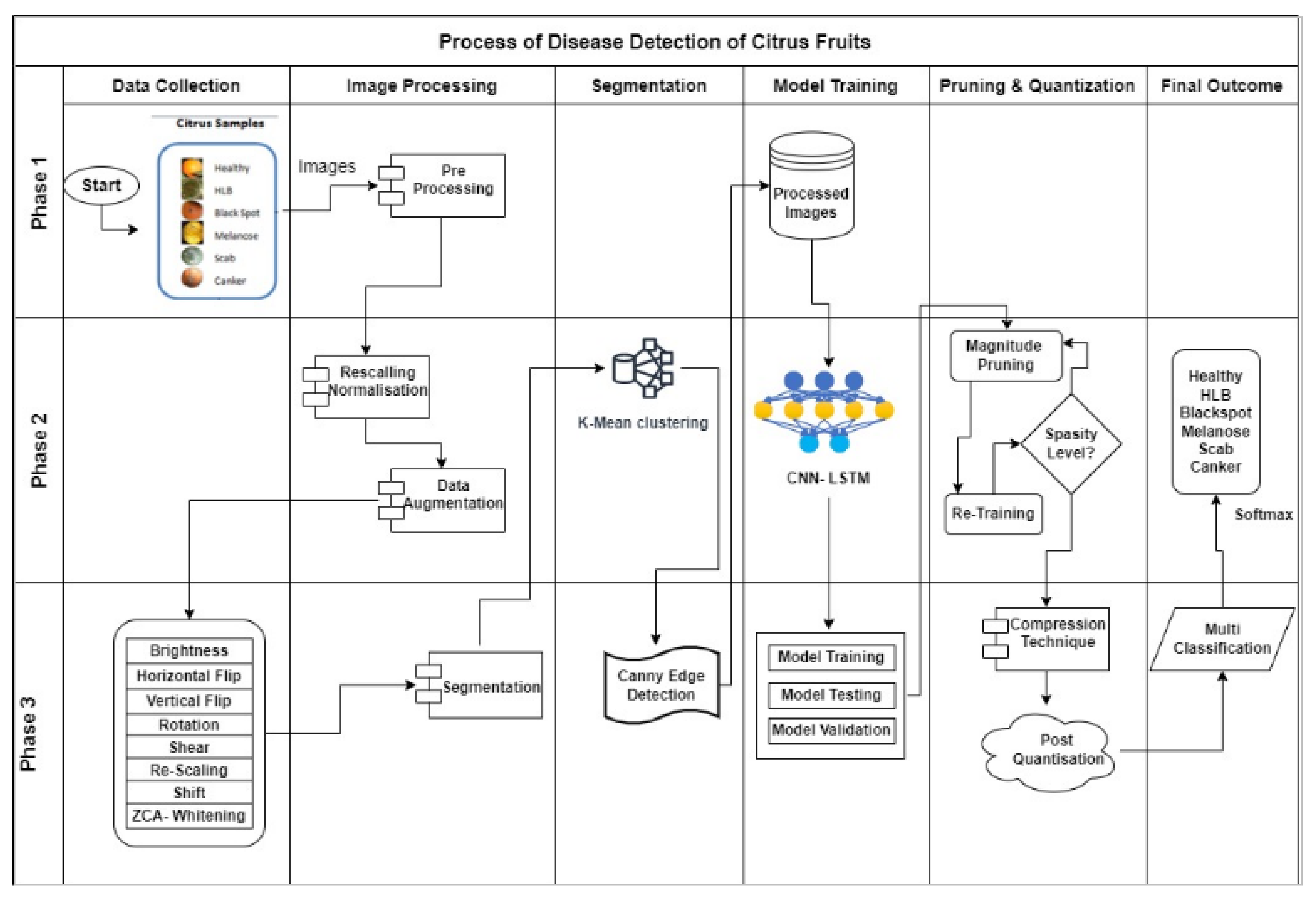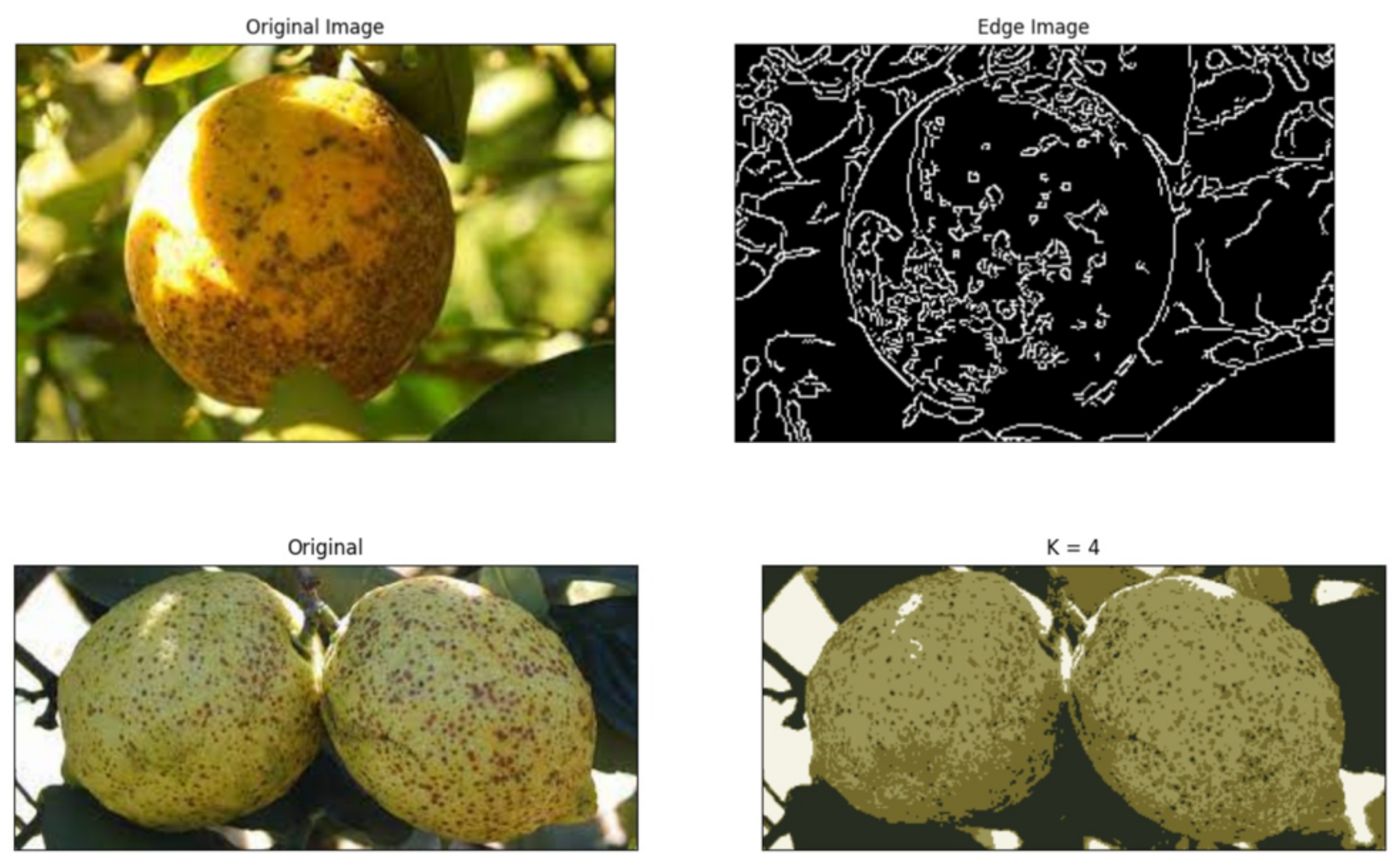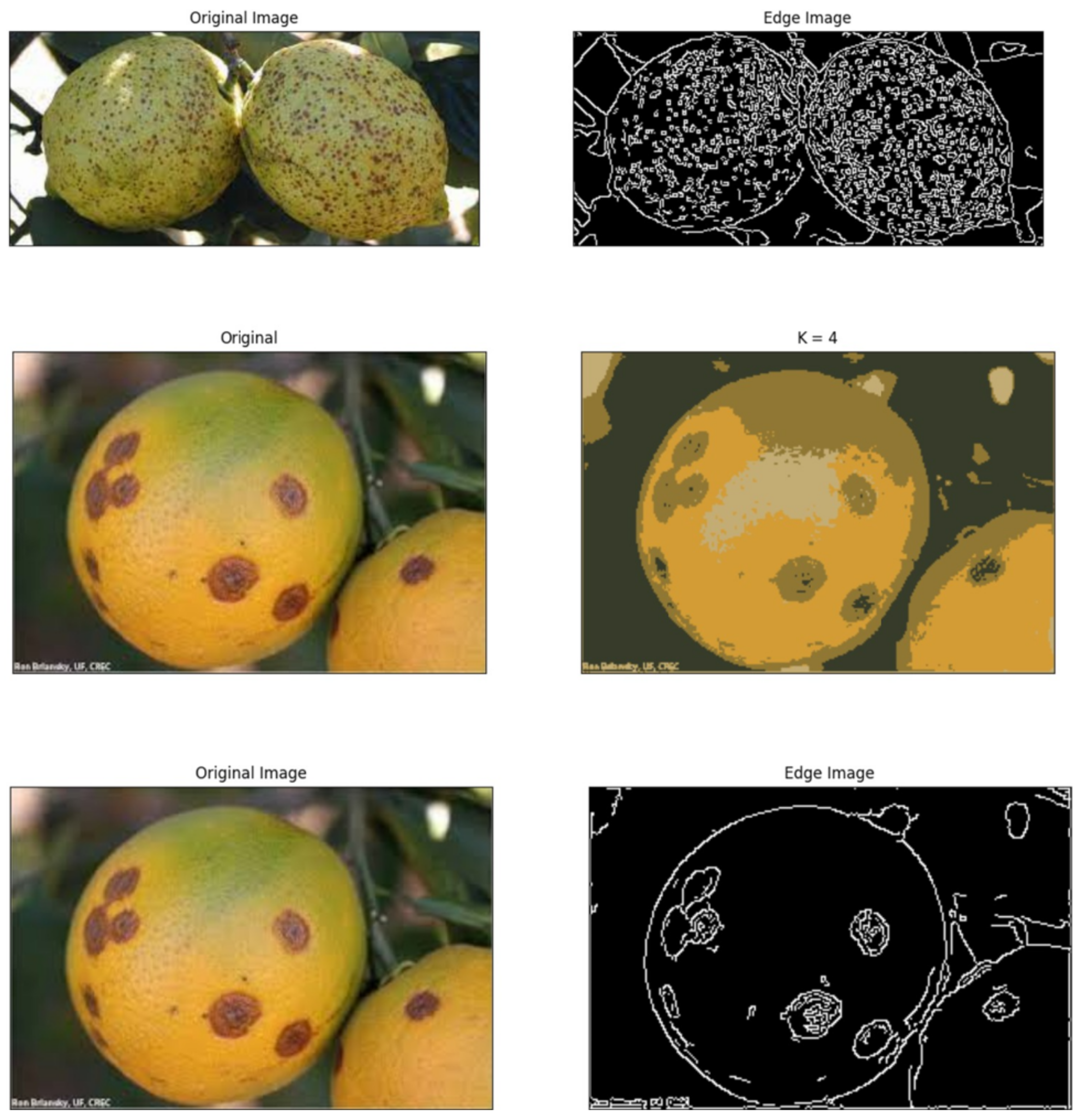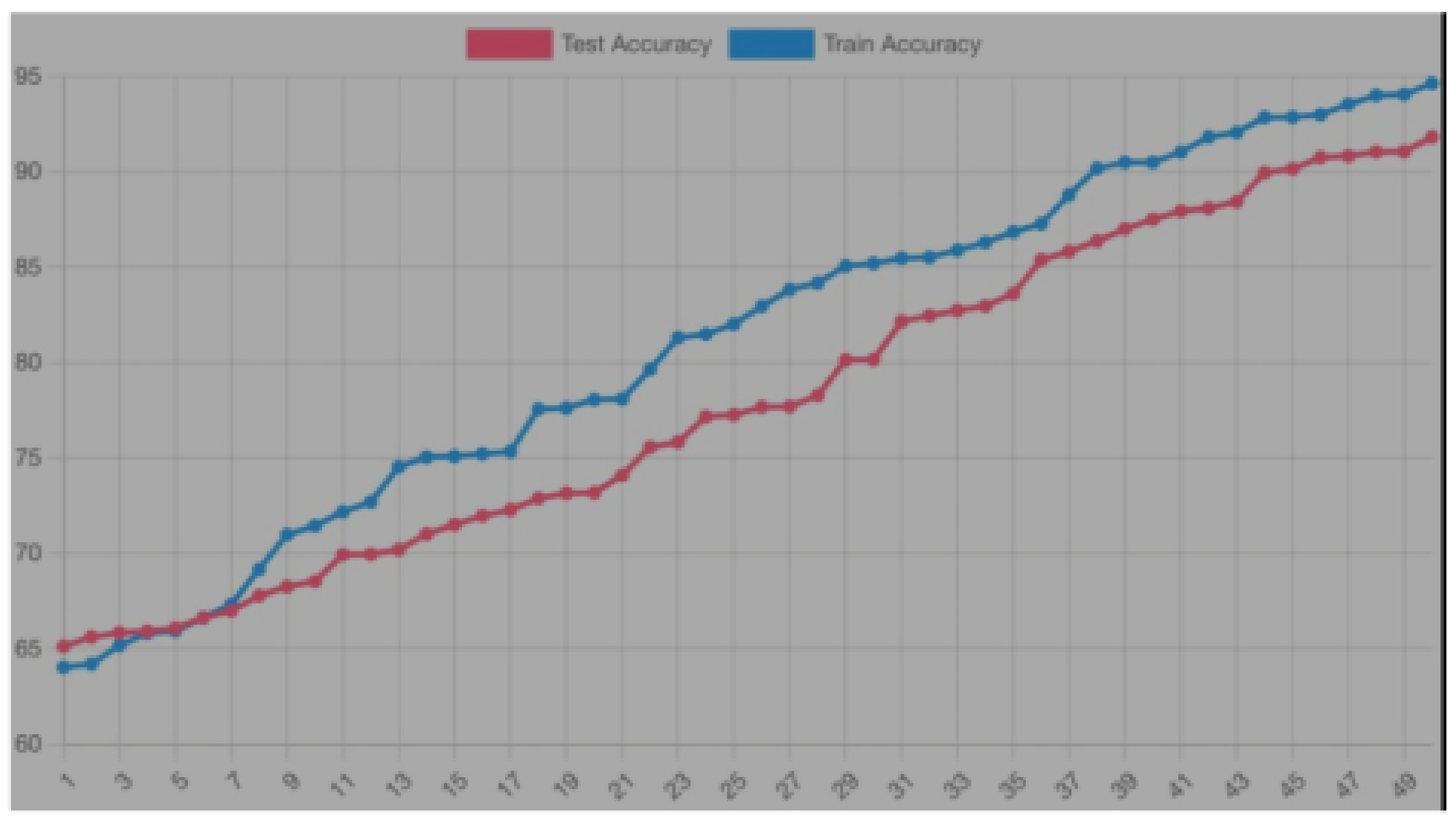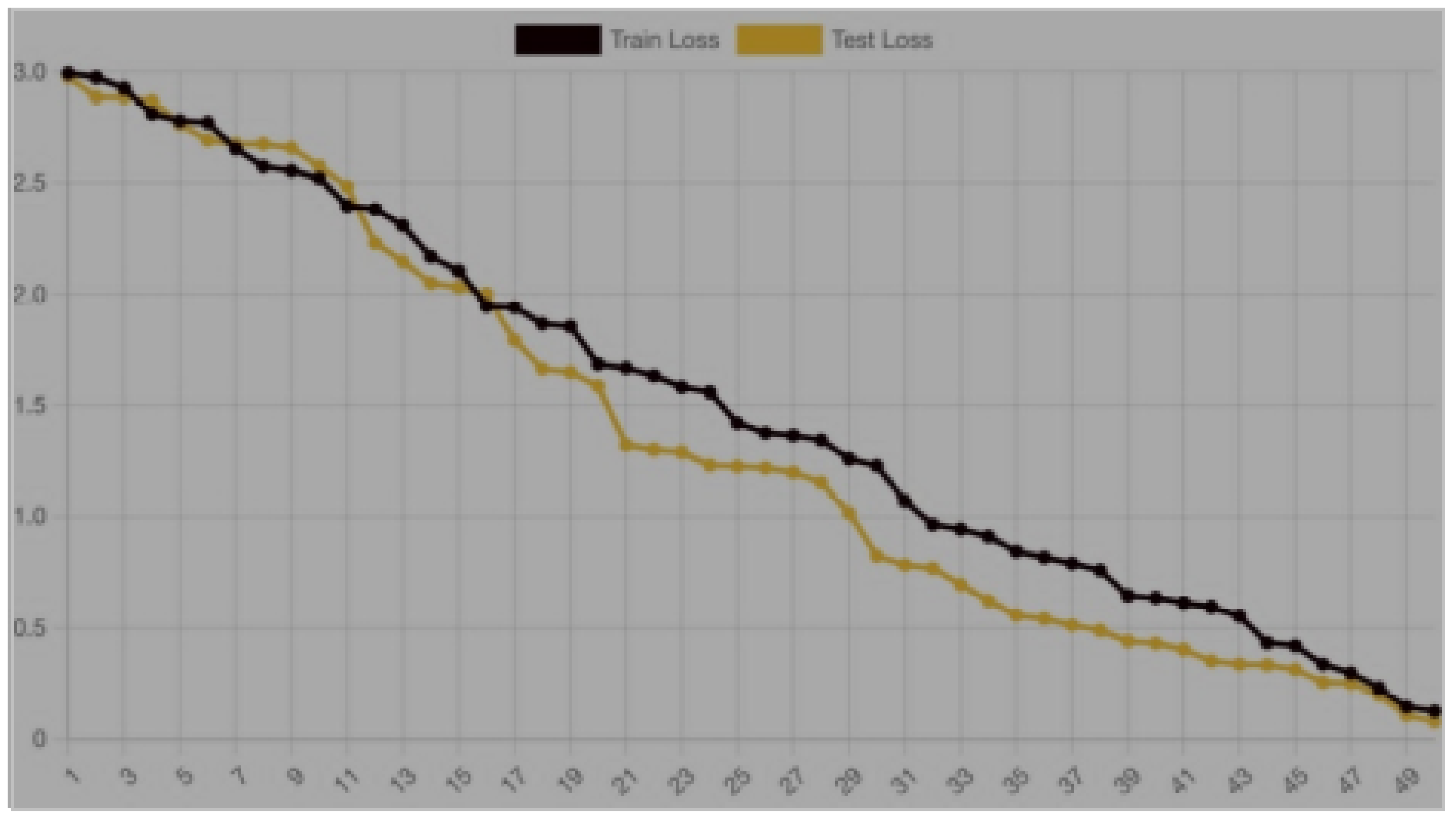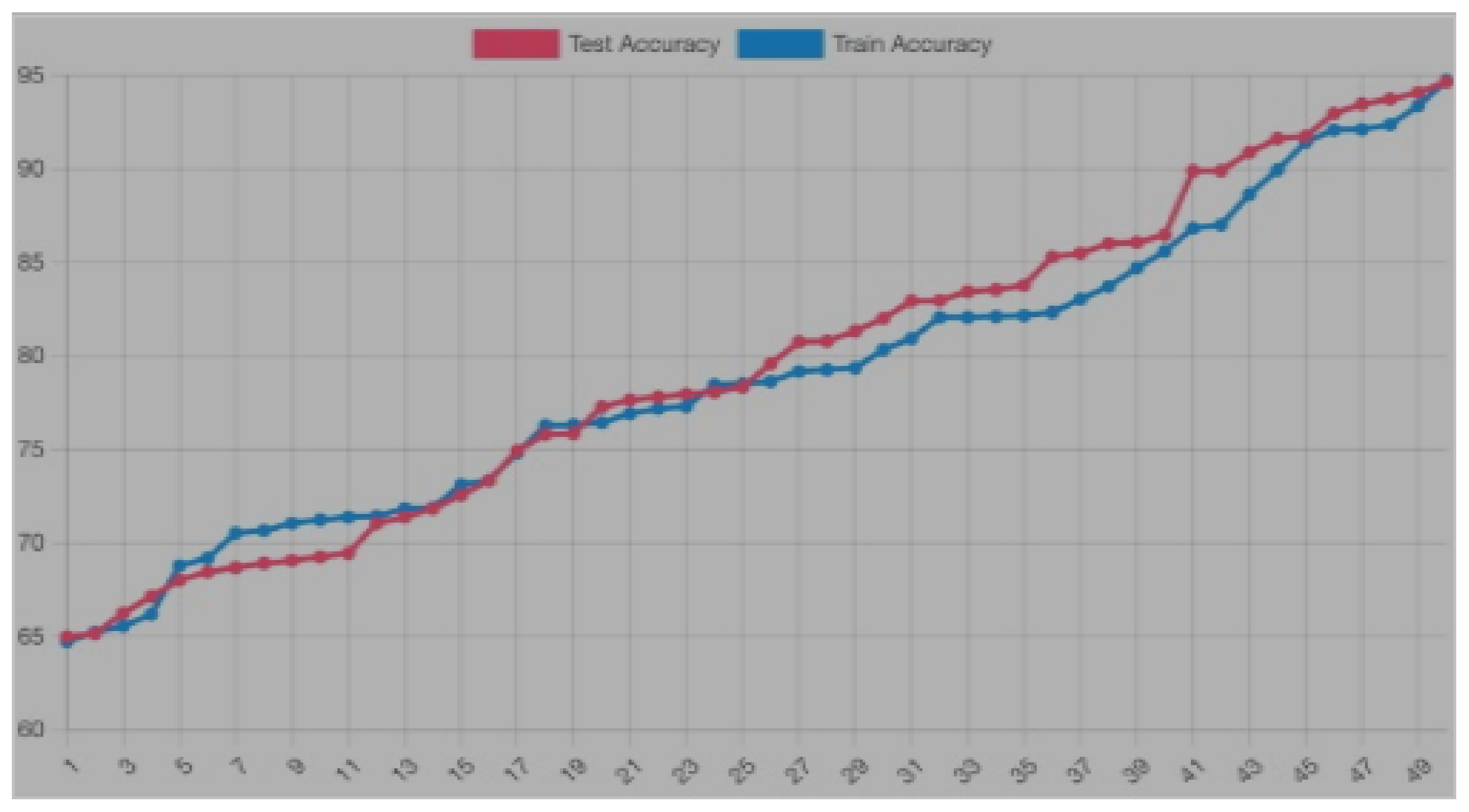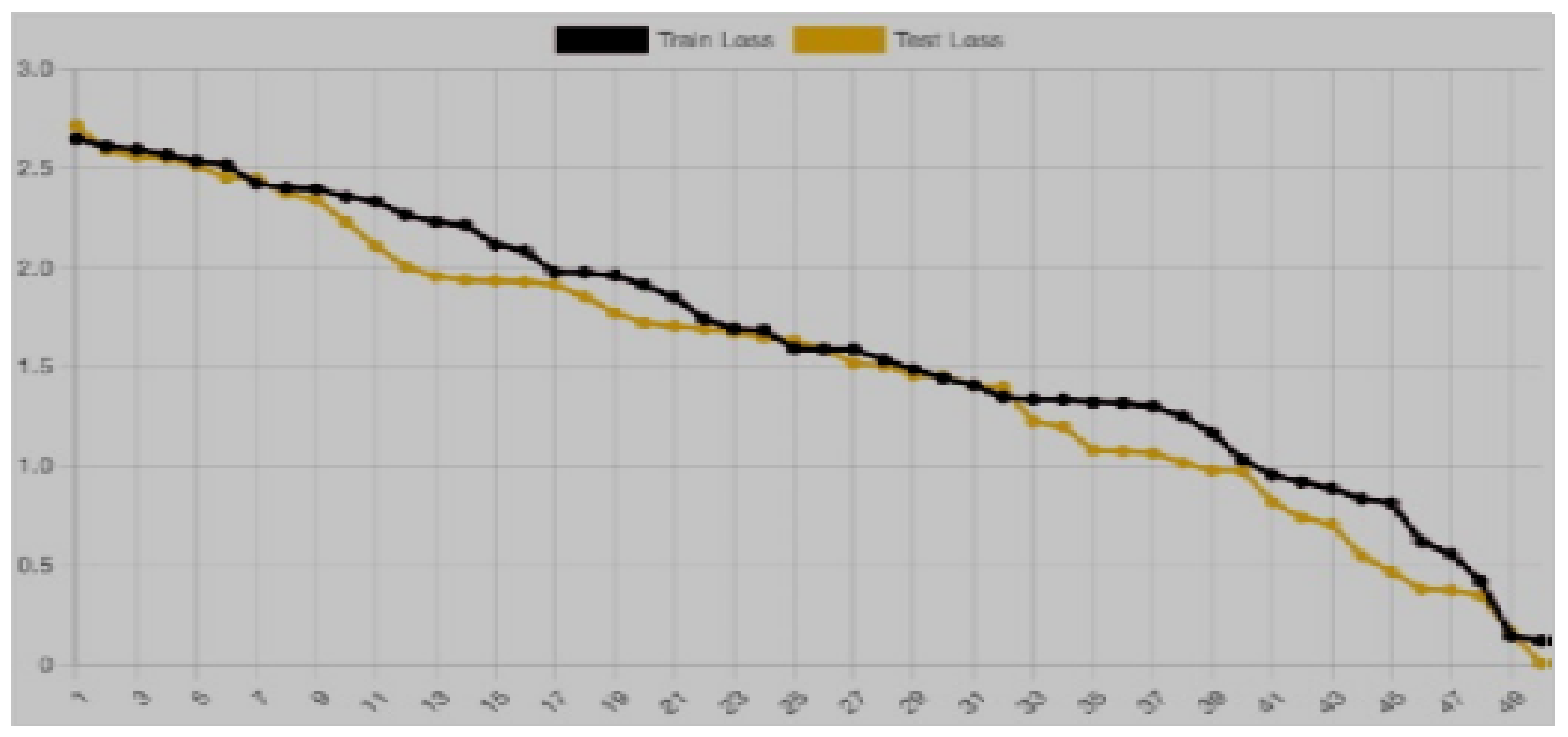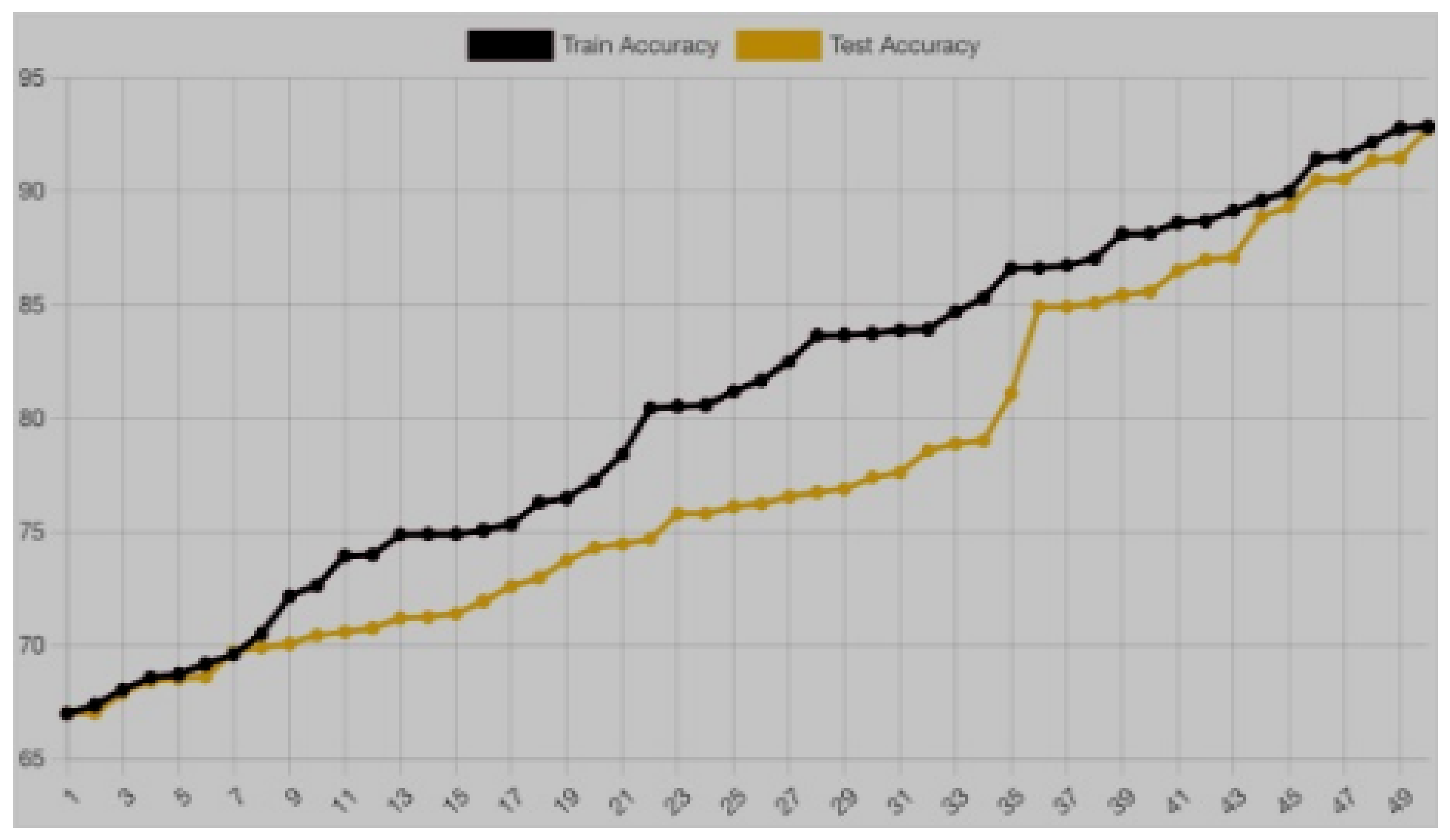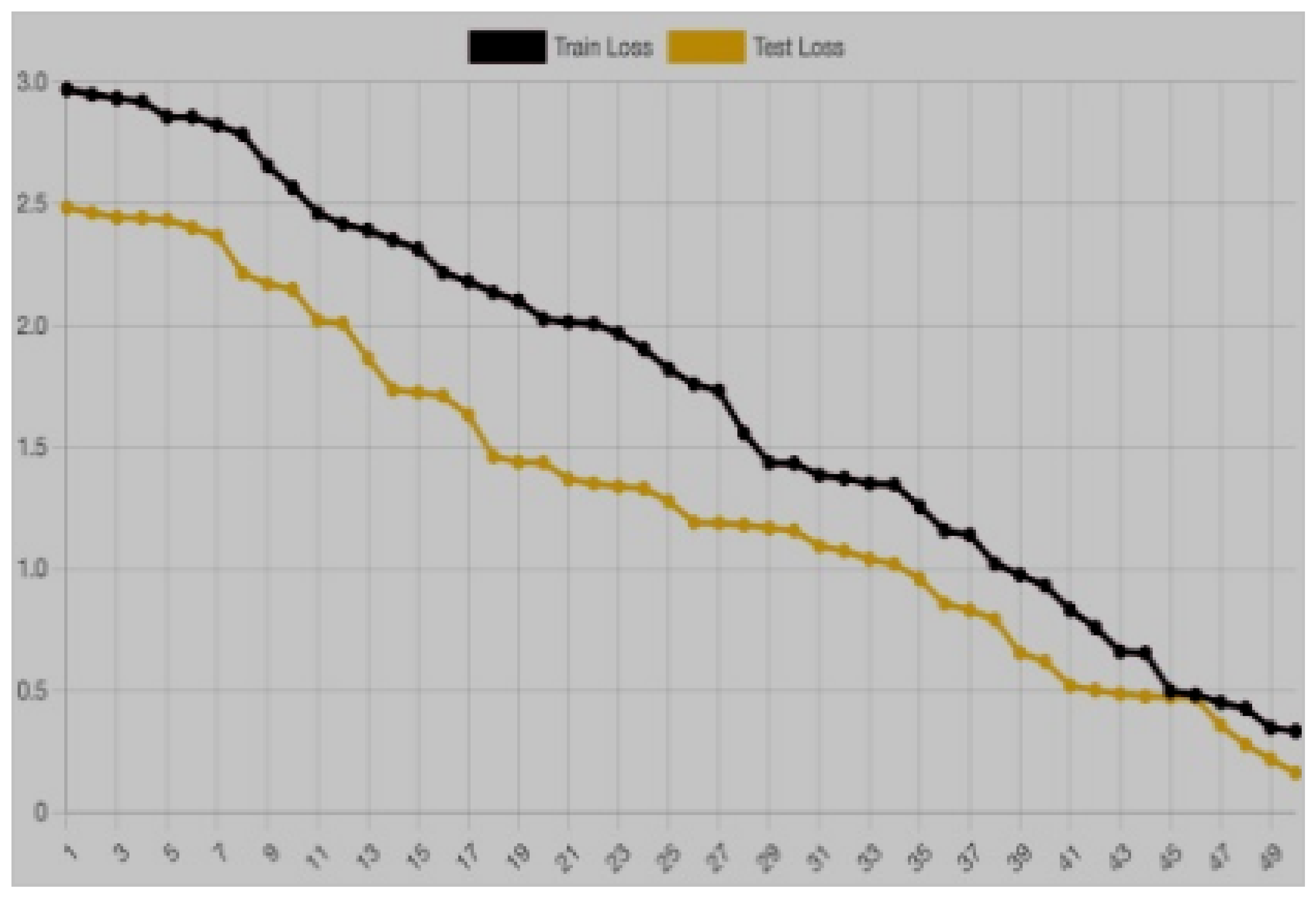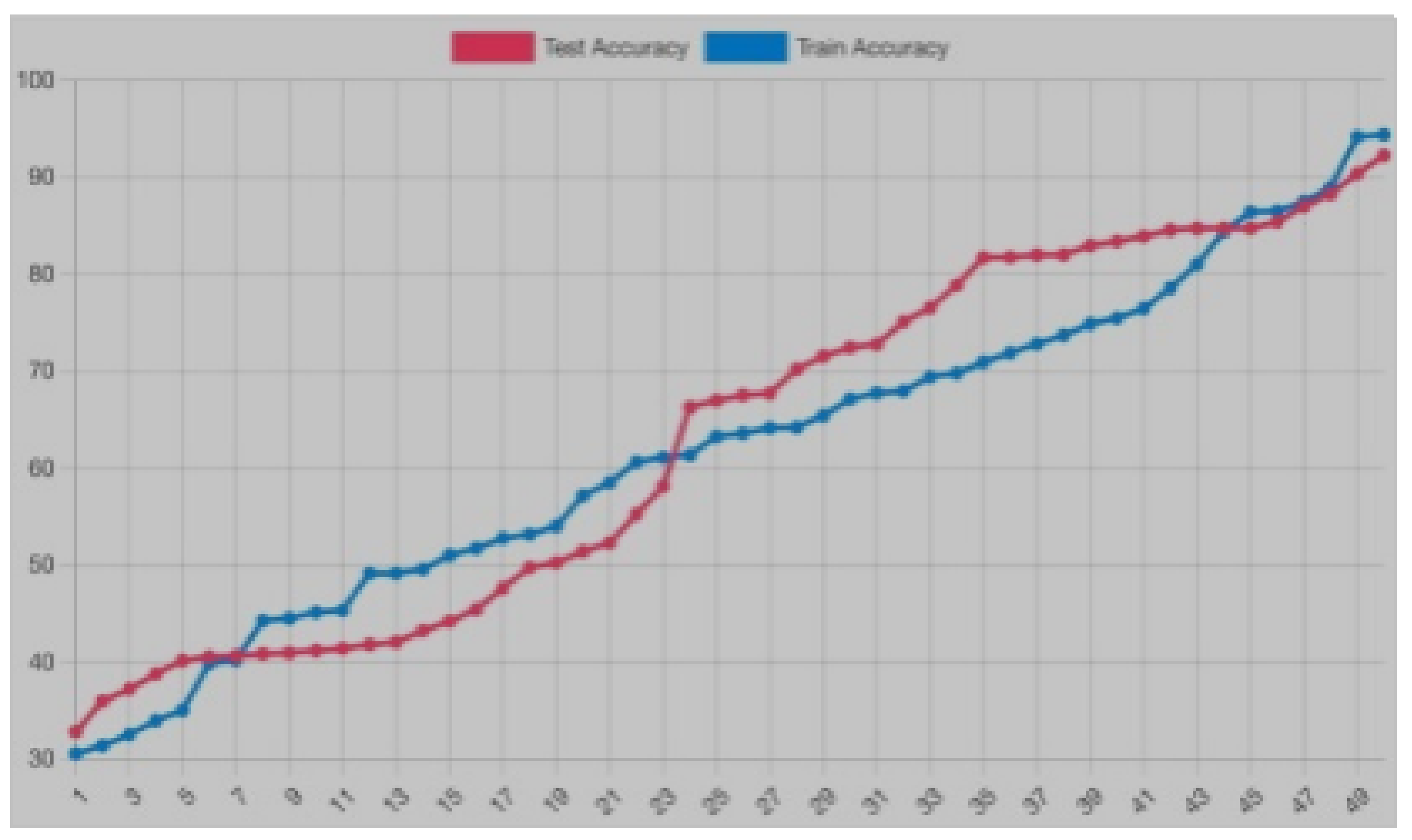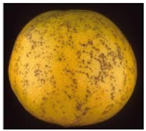1. Introduction
In the past few years, fruit disease classification has been the topic of intense dispute among researchers all around the globe. The establishment of systems that can limit human appearance is the goal of computerized assessment and categorization. In the current situation, precise examination of fruits and veggies is prominent. The FAO-2022 report estimates that 197,198 million tonnes of citrus fruit will be produced globally, with oranges comprising more than 50% of that production. Producing quality fruits at a lower cost while ensuring they are free of disease-causing insects and viruses is a goal for farmers [
1]. This goal can be achieved by using the right automated standards and proactive maintenance methods. Fruit diseases pose a serious threat to citrus growing in the present era. Since a few tainted fruits could spread the disease to just the opening sequence throughout data-processing or delivery, the citrus industry needs quick and automated disease screening throughout post-harvesting [
2].
The advancement of image processing by AI-based techniques, i.e., machine learning, and deep learning have great resilience and consistency at low prices, high precision, and speed capability to evaluate citrus fruits disease and quality under bad weather and typical ecological factors. The edge computing significant gains have experienced a difficult development process for IoT solutions [
3]. The conventional neural network’s (CNN) scope is limited in order to meet increasing demands due to its rigid establishment of effectiveness. Deep learning forecasts mainly focus on a set of variables, which can help to produce a large weight matrix. These models demanded a significant of computational and memory resources to train and validate. However, it is difficult to implement these criteria on low-cost devices or technology with few resources to deal with [
4].
1.1. Background Research
The learning categories, i.e., supervised and unsupervised can be utilized in deep learning methods. The performance measures differ based on the specific application area wherein deep learning has been employed. The complexity of the Hyperparameter selections makes it difficult to design an effective DNN model or choose the best DNN model for a particular application [
5]. It can be beneficial for the DNN modeling planner or the developer to have a sound knowledge of the choices among speed, precision, storage, cost, and other running processes [
6]. There are numerous uses for deep learning methods on edge devices, including object recognition, language processing, networking protocols, the Internet of Things, voice recognition, and image segmentation. Numerous quick-performing DNN inference architectures have been created in order to help these services achieve their latency constraints.
Figure 1 shows the techniques of rapid analysis in fruit disease classification.
1.2. Method for Fast Interference
Three significant experimental models are addressed in this examined in this section: There are three types of computations: (a) on-device mathematical computation, wherein DNNs can run just on edge devices; (b) Architecture based on an edge server, in which the input is collected from the edge nodes and directly transferred with one too many edge computing servers for calculation; and (c) Architecture based on joint computation feature among end computing devices, cloud, and edge computing servers. There have been a lot of studies carried out on how to make deep learning run more quickly on devices with limited resources [
7].
These initiatives can help the entire edge ecological system by minimizing the latencies of a DNN since operating on edge devices or edge computing platforms servers. Machine learning investigators concentrate on modeling the system with a smaller set of variables in the Convolutional neural network, lowering storage and operation delay while striving to maintain high precision when constructing DNN algorithms for resource-constrained systems. DNNs can also be allowed on edge nodes by reducing the number of layers and lowering the model. Typically, these techniques aim to reduce the size of the current DNN modeling while preserving as much precision as possible in comparison to the previous model. Parameter reduction, parameter filtering, and information extraction are some common techniques for prototype compression. Here is a quick summary of these strategies [
8].
1.3. Quantization and Pruning Techniques
Using low-bit width values instead of expensive floating-point operations such as multiplication and division, variable reduction compresses the parameters of a conventional DNN. The lowest crucial aspects are eliminated in the pruning process (close to 0). There have been both separate and combined considerations of the quantized and pruning methodologies [
9].
This research presents efficient fruit disease identification and classification model using deep learning-based CNN and LSTM techniques with edge computing. The key contribution of the research includes.
Citrus fruits dataset with various diseases is gathered from various online sources and submitted to edge computing devices for categorization. Edge computing devices which have a limited number of resources are unable to run complex DNN-based applications.
This research utilizes a light processing-based CNN-LSTM model with edge computing for Citrus fruit disease classification. We have also quantized and pruned the edge network. So that the proposed model can able to run on limited resources.
The proposed model utilizes three phases. Phase 1 includes data collection, and data pre-processing, and phase 2 includes re-scaling of images, data augmentation, and image segmentation by K-mean clustering and canny edge detection, also applying CNN-LSTM for model training. Phase 3 is the final process which includes testing of the images and classification. In this phase, experimental analysis is performed using Magnitude-Based Pruning, and in the second step Magnitude-Based Pruning with Post Quantization.
The Online Kaggle dataset is utilized in this research. The proposed model and existing CNN model are compared based on various performance parameters, i.e., precision, recall, f-measure
The organization of the article is as follows: the dataset used for the implementation of the model is described in
Section 2. In
Section 3, the proposed edge computing configuration, including pre-processing, data augmentation, classification, pruning, and quantization processes is defined. The outcome and performance evaluation are included in
Section 4.
Section 5 concluded the proposed work.
2. Literature Review
Citrus fruit analysis, i.e., fruit quality, disease identification, and classification are hot areas of research. This section covers the comparative analysis of various existing works in the field of citrus fruit disease classification.
Edge Computing is a hot topic that the research community is closely associated with because of its implications for science, technology, and industry. The incorporation of the ETSI guidelines has significantly strengthened the case for edge computing. However, many of the present MEC biological studies fall short, which prevents and invalidates their implementation [
10]. A wide range of innovative rapid prototyping, functionalities, and implementation seems to be critical to overcome this discrepancy. Early initiatives can prove the functionality, restrictions, connected techniques, and application frameworks for multi-edge factors affecting the adoption of edge computing [
3]. A large amount of IoT statistics is forwarded to the cloud through the cloud-based architecture for strategic decision, research, and data processing. It could cause not just limited availability on the data center but also increased communication overhead, possibly negating the benefits of the cloud. To deal with these challenges, investigators are looking for new distributed network models for IoT-based computing devices and networks, and technology.
One such method that is receiving a lot of attention among both academia and industry experts is edge computing. The fundamental idea behind the edge computing technique is to shift the processing of digital information from remote servers to relatively close machines. It is encouraging to see the advancement of more massively parallel, low-latency, and efficient edge computing devices and IoT-edge systems [
4]. To determine an optimal technique to determine image imperfections on the citrus fruit skin, an associated with advanced PCA with B-Spline illumination clarification assessment was incorporated. Machine learning and computer vision methods carry out image processing. The proposed model helps to estimate and retrieve useful information for fruit disease images concerning [
5].
Various IoT-based devices and sensors are widely used to collect fruit images. Typically, hyperspectral functionality provided obtained 2D statistics at a period and checked all over three-dimensional. Premised on the filtering method multispectral imagers as well as imaging systems are classified into two types: optical filtration and digitally configurable filters [
6]. The most frequently used image transmission process is a 3-CD webcam with illumination gray walls accented with gray files [
7]. Numerous image fusion strategies, such as pixel level, quantitatively, and metaphorical level, were formed in recent decades. Image enhancement is being used by investigators to recognize orange fruit disease [
8]. The terms near-infrared spectrograph and spatial frequency acquisition refer to two distinct edge devices, namely the segments, and sub-FT-spectrometer. A multivariate regression prototype was utilized to evaluate these two small and medium companies and FT-spectrometers [
9].
Image enhancement can be employed to detect and classify diseases at a lower cost. In the proposed model an enhanced Image principal component analysis is implemented to apply reduction on orange images. The Edge detection module in the proposed model mainly extracts seven attributes from the orange fruit image dataset. Next, then, a method of deep learning is employed to detect orange fruit conditions at their earliest stages of growth [
10]. The study suggested an image processing technology for evaluating the various imperfections in citrus fruits and detecting malformations in fruit. A failure mark’s symptoms reveal the character of the disorder and suggest the ideal treatment regimen [
11]. To find the desired diseased region, segmentation is conducted using DE color change. In addition, color statistics and texture analysis were used to classify the disorder [
12].
Lime and orange citrus fruit with pharmacological decays have lower economic potential. The investigator proposes a method of image handling to recognize types of diseases on X-ray image data of lemons and oranges fruit. The image sequence was automatically classified using K - means and Naive Bayes similar techniques [
13]. The researchers utilized the partial least squares analysis to look into the connection between granulation psychological disorder incidence and quality characteristics [
14]. The categorization of infectious illnesses affecting citrus fruits has been incorporated using heuristic methods that combine Deep Convolutional neural networks& random forest methodologies [
15].
A modern AlexNet infrastructure that utilized deep learning has been used to detect diseases successfully. This method was divided into four major steps: pre-processing, edge detection, object recognition, and categorization [
16]. The characteristics of the input object were first improved through pre-processing. After that, the images and videos were categorized using the Based segmentation method. An Alex-Net framework was initially presented as just a filtration feature. A random forest method was finally utilized for the categorization of citrus fruit diseases. Ten independent factors were employed as the neural network’s feedback to identify the feature set [
17].
RNNs are a type of Neural Network model that uses the immediately preceding step in the process outcome is utilized as direct input within the initial stage. The most popular uses of RNNs include the classification of sequences, emotions, images, and videos [
18]. RNNs are a type of network wherein node links establish a sequentially ordered graph. It resembles a linked sequence of items from a deep network. Each one is communicating with the individual ahead of them in sequence. An RNN is trained to recognize patterns and behaviors, whereas a CNN is trained to recognize patterns throughout space [
19].
SVM classifiers [
20] were utilized to classify citrus fruit after modifying the existing CNN method for the classification procedure. Feature values were accumulated utilizing k-mean cluster analysis. The multi-class problems damage the overall system effectiveness even though they decreased the rate of false positives. The researchers [
21,
22] developed a segmentation technique to incorporate prediction models. It has enhanced the segmentation algorithm in identification for sensing the three separate types of disorders. Images of lemon fruits with softness and bacterial blight were used in the testing. In order to categorize the binary classification diseases, backpropagation architectures were used. Although this remedied the multi-class problem, the data processing is extremely complex.
Table 1 represents the comparative analysis of the performances of different detection model using various kind of pruning techniques.
3. Materials and Methods
The complete process of implementing the proposed model for detecting the disease in a multi-class framework is further explained. The flow of steps is divided into several necessary modules into subsections explained in detail below, beginning with image collection and image processing for the training of the CNN-LSTM model with compression technique over an edge computing environment.
3.1. Dataset
Fruit diseases lead to depleted marketability and quality in the field of farming, which becomes the root cause of global loss of financial return. Citrus is a significant provenance of vitamins A and C all around the world. Citrus illnesses, on the other hand, harm the quality and yield production of citrus fruit. Citrus fruits such as lemons, grapefruit, oranges, and limes are liable to a diversity of citrus diseases such as scabs, anthracnose, black spots, HLB, and all other bacterial deformities. At all phases of object detection investigation, from the training process through monitoring the effectiveness of detection systems, adequate datasets are necessary. The image samples taken from the online dataset were collected from three sources, i.e., World Wide Web, plant village, and Kaggle.
Table 2 represents different classes of citrus fruits that we have used for the classification model.
3.2. Proposed Model
The existing deep learning models, i.e., DNN, and CNN are unable to perform well on edge computing devices due to limited resources. It can be resulting long delays in processing, high latency, poor accuracy, and high computation time. In this research, we are presenting a CNN-LSTM with edge computing for citrus fruit disease early detection and classification. To identify or categorize citrus fruit diseases in a multi-classification way, it is crucial to develop a more robust and efficient model. In this research, the fruit sample images (healthy and 5 categories of unhealthy) were collected from online data sources, i.e., Kaggle, of plant disease.
Figure 2 illustrates the broad sense architecture of the proposed CNN-LSTM system model. Under this system, edge computing servers seem to be relatively close to the client computers/device, as well as the data transmission delay between the client computers and the edge computing servers seems to be significantly smaller for a cloud remote server. The major part in training A cloud can be implemented on edge servers to provide end users with quality service, and data acquired might be continuously transferred electronically to alter the system.
Figure 3 the working steps of the proposed model.
Figure 3 provides a brief explanation of how citrus fruit diseases are classified. The proposed model utilizes three phases. Phase 1 includes data collection, and data pre-processing, and phase 2 includes re-scaling of images, data augmentation, and image segmentation by K-mean clustering and canny edge detection, also applying CNN-LSTM for model training. Phase 3 is the final process which includes testing of the images and classification. In this phase, experimental analysis is performed using Magnitude-Based Pruning, and in the second step Magnitude-Based Pruning with Post Quantization. The key steps include (a) Data pre-processing, (b) Augmentation, (c) Training phase, (d) pruning process, (e) Quantization process, and (f) Measuring the performance and analysis.
After applying the image processing technique such as rescaling, data augmentation, and k-means clustering algorithm, the processed images are fed into the proposed DNN model. The proposed CNN-LSTM model mainly contains four modules.
Its first module is composed of a collection of relevant nodes.
The second module deploys edge computing services and resources,
The third module contains a classification algorithm and prediction model, and also includes a pruning method with quantization features, and
The final module deploys application programs over edge computing devices.
Each of the modules has its functionality. A link among platform-based both local as well as remote processes is provided by the third phase component. The information is gathered domestically first from public platforms, and after a pre-processing is applied to eliminate the non-relevant features. Various groupings have been created similarly to offer better accessibility to possible application circumstances. Users have access to the console’s services and applications via module 4 which is the final module. As a result, the layer is responsible for providing the client with complete access to each of the resources delivered by an edge computing device. This component gives network virtualization processing the ability to access the tasks that require, analyzing and evaluating the results. An online dataset, which consists of various fruit (citrus fruit) diseases, is sent to the native collector device. CNN with LSTM and edge computing-based proposed model is utilized with magnitude pruning and quantization for an internet connection is made. The visualization layer enables remote access to deep learning model outcomes.
The edge computing servers lighten the load on the communications infrastructure when compared with the most sophisticated cloud architectures. A few issues caused by poor contrast, including such colored lights as well as flashing, etc., can be removed by pre-processing the input images. As limited disparity images reduce the histopathological segmentation’s precision in the domain of image processing, data preprocessing plays an important role. Because each of the images within the learning algorithm is sparse but also have distinct size, and widths, so we need to normalize it to the comparable image aspect in order to determine the optimal one. As a result, all fruit images within the training dataset have been scaled to (256 × 256). Each image has an RGB color mode, a 32-count filter, a [3,3]-sized kernel, [2,2]-sized strides, and [2,2]-sized pools. The CNN method with LSTM can also be used by edge computing servers for feature extraction and classification to acquire additional data without incurring labeling costs. In addition, information augmentation is used to improve the functionality of the constructed proposed model CNN-LSTM [
23].
3.3. Pre-Processing and Segmentation
In order to update the properties of each learning algorithm, feature selection methods are generally a necessary and even critical step. In reality, unscaled statistics make visualizations challenging and, quite saliently, they can impair the forecasting effectiveness of several machine learning methods. The correlation of several gradient-based estimation techniques is also affected and even prevented by this kind of statistic.
On each image, in this case, we used a rescaling methodology. Additionally, it helps to enhance the capabilities of CNN models through the incorporation of data augmentation features As a result, 8 standards are been added to complement our training dataset and testing dataset. These standards include (a) Horizontal flip process, (b) Vertical flip, (c) Brightness improvement, (d) Rescaling process, (e) Shear, (f) ZCA-Whitening, (g) Rotation in different angles, (h) Height shift, and (i) Width shift [
24].
After employing the augmentation functions, the 2556 citrus specimens that were at first obtained, along with six classes, expanded to 20,448. For image quality analysis a segmentation process plays a vital role. Image segmentation is the division of a digital picture into several separate areas, each of which contains pixels that have comparable characteristics. To extract the target area (Segment) from the Citrus image, a K-Means technique is used. The data collected is clustered or divided into the K clusters and components predicated on the K-centroids. It reduces the total squared intervals among each point and also the centroid. An edge retrieval technique called the “Canny-edge” method is used after K-means clustering. The Edge detection by the Canny method is an image acquisition method that employs noise suppression while detecting an image’s edges.
Figure 4 represents outcome of the segmentation technique applied on citrus fruit samples. The Algorithm 1 consist of various steps that have to be followed for image processing and segmentation.
| Algorithm 1: Proposed Algorithm for Image Processing. |
| Input: Citrus fruit |
| (1) | Input the colored image(Img) |
| (2) | Perform Pre-processing Resizing (256 × 256) |
| (3) | Performed Data Augmentation using |
| (4) | Convert each image from RGB color space to HSV |
| (5) | Applied K-means clustering, where cluster (k) = 4 |
| (5.1) | Select k as the desired quantity of clusters to be discovered. |
| (5.2) | Decide which k clusters to arbitrarily allocate the data points across. |
| (5.3) | then determine the clusters’ centers. |
| (5.4) | Determine the separation between the data points and the clusters’ centers. |
| (5.5) | Reroute the data points towards the closest clusters according to their distance first from the center. |
| (5.6) | Recalculate cluster center once more. |
| (5.7) | Continue steps 5.4 to 5.6 as necessary to achieve the specified number of repetitions or until the measured values do not impact the clusters. |
| (6) | Regenerate the clustered Image |
| (7) | Performed Canny Edge Detection method |
| (7.1) | Noise reduction; |
| (7.2) | Gradient calculation; |
| (7.3) | Non-maximum suppression; |
| (7.4) | Double threshold; |
| (7.5) | Edge Tracking by Hysteresis. |
| (8) | Stop |
4. Experimental Results and Discussion
The efficiency of the model is evaluated and determined with 80-20 cross-validation. Firstly, the model is predicted with the baseline CNN model and different evaluation parameter is calculated. Then the proposed CNN-LSTM model is evaluated using an SGD optimizer to enhance the parameter of cross entropy.
Table 3 represented the confusion matrix generated from the proposed CNN-LSTM model for each class of citrus fruit diseases.
Table 4 shows the values of accuracy, precision, recall, and f-score achieved from the proposed model for each class of disease.
Table 5 represents the comparison of different parameters evaluated through different approaches. The evaluation parameter used for determining the efficiency of the model is the accuracy, loss, precision, recall, F-score, and model size. Firstly, different evaluation parameters are derived from the baseline CNN model without using any compression technique. Then, all the evaluation parameter is determined by using the proposed CNN-LSTM model without using the pruning technique. After that, we determine the different parameters by employing the proposed CNN-LSTM model along with a magnitude-based pruning algorithm. Then, the proposed CNN-LSTM model along with pruning and post-quantization technique is implemented on the given data set and different evaluation parameters were determined.
It is observed from the table that the accuracy achieved using the baseline model without using the compression technique is 96.93 and the loss achieved is 0.17. The accuracy achieved by the proposed CNN-LSTM model without compression technique is 98.87 and the loss is less in this scenario which is 0.0831. It is observed that the reduction in model size by using the proposed model is 6.67%. Then the proposed model is implemented by using a magnitude-based pruning technique and it is observed that the reduction achieved in the model size is 50.29%. The size of the model can further be reduced by using the post-quantization technique without compromising the accuracy of the model. The
Figure 5 represents the test accuracy and the training accuracy of the baseline CNN model and
Figure 6 represents the training and test loss obtained of the baseline CNN model without compression technique. In the
Figure 5 x-axis represents the number of epochs and
y-axis represents the accuracy obtained during the testing and training phase. Similarly, in
Figure 6 x-axis represents the number of epochs and
y-axis represents the loss obtained during the testing and training phase.
The
Figure 7 represents the test accuracy and the training accuracy of the proposed CNN-LSTM model and
Figure 8 represents the training and test loss obtained from the proposed CNN-LSTM model without compression technique. In the
Figure 7 x-axis represents the number of epochs and
y-axis represents the accuracy obtained during the testing and training phase. Similarly, in
Figure 8 x-axis represents the number of epochs and
y-axis represents the loss obtained during the testing and training phase.
The
Figure 9 represents the test accuracy and the training accuracy of the proposed CNN-LSTM model magnitude-based pruning and
Figure 10 represents the training and test loss obtained from the proposed CNN-LSTM model with magnitude-based pruning. In the
Figure 9 x-axis represents the number of epochs and
y-axis represents the accuracy obtained during the testing and training phase. Similarly, in
Figure 10 x-axis represents the number of epochs and
y-axis represents the loss obtained during the testing and training phase.
The
Figure 11 represents the test accuracy and the training accuracy of the proposed CNN-LSTM model with magnitude-based pruning followed by post-quantization technique and
Figure 12 represents the training and test loss obtained from the proposed CNN-LSTM model with magnitude-based pruning followed by post quantization technique. In the
Figure 11 x-axis represents the number of epochs and
y-axis represents the accuracy obtained during the testing and training phase. Similarly, in
Figure 12 x-axis represents the number of epochs and
y-axis represents the loss obtained during the testing and training phase.
Figure 11 test accuracy and the training accuracy of the proposed CNN-LSTM model with pruning and post quantization and
Figure 12 graph represents the training and test loss obtained by the baseline model.
5. Conclusions and Future Work
The Implication of the Research
Sustainable farming: Providing the farmers with direct access to disease information at the earliest feasible time. Improve the citrus industry’s economy by predicting diseases by enhancing fruit disease detection’s value in a limited resource environment. The parameter quantization compresses the parameters of the existing DNA by converting from floating point numbers to low-bit numbers by avoiding Complex and expensive floating point multiplication computation. On the other hand, pruning helps in removing the least significant or less important parameter which is approaching zero. By combining the pruning and quantization the size of the deep model was considerably reduced. Particularly for edge and mobile devices prone deep models can be used on it devices without further modifications. Offloading the computation of deep CNN from end systems to the more powerful system such as edge servers or the cloud is considerably useful. Nevertheless, for the applications such as agriculture, and medicine, forecasting the clouds are not suitable for edge servers as these applications require short responsive time.
Citrus fruit disease analysis plays a vital role in fruit production. It motivates the research to develop an efficient fruit disease detection model. Edge computing devices are widely used in the agricultural sector. Due to higher resources/computing a traditional CNN-based-fruit disease detection model is not much efficient for edge computing devices with limited resources. This research presents a hybrid model using CNN and LSTM with edge computing.
The proposed CNN-LSTM model is competent for functioning on low-resource platforms, and significant size reductions. This allows CNN-LSTM to run quickly on platforms with limited capabilities. In the experimental analysis, the online Kaggle dataset for fruit disease is utilized. The proposed model and existing CNN models are compared based on various performance-measuring parameters. The experiments were performed using Magnitude-based pruning with quantization and without pruning for proposed and existing methods.
Based on experimental outcomes it is observed that the accuracy achieved using the baseline model without using the compression technique is 96.93 % and the loss achieved is 0.17. The accuracy achieved by the proposed CNN-LSTM model without compression technique is 98.87 % and the loss is less in this scenario which is 0.0831. It is observed that the reduction in model size by using the proposed model is 6.67%. Then the proposed model is implemented by using a magnitude-based pruning technique and it is observed that the reduction achieved in the model size is 50.29%. Size of the model can further be reduced by using the post-quantization technique without compromising the accuracy of the model.
The outcomes are predicted to encourage the utilization of pruning with quantization a valid method for a compression ratio of CNN-LSTM advance models for execution in limited resource circumstances. The limits of the approach are evident when the edge network involves elements of the same type. This research can be further developed by applying it to real-time agricultural images in future research.
